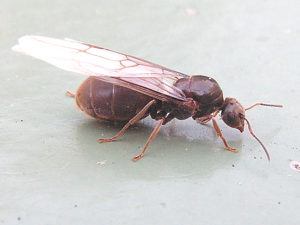This website uses affiliate links. If you purchase a product or service after clicking a link on this site – we may earn a commission (at no additional cost to you). As an Amazon Associate, we earn from qualifying purchases.
Ants are social insects that live in colonies. The colony consists of three types of ants: worker ants, queen ants and male ants.
Worker ants are the ones who do all the work in the colony. They forage for food, defend the colony and look after the queen ant’s eggs. Queen ants are female and they produce eggs for their colony. Male ants have no role in the colony – they leave to mate with other queens from other colonies when they reach a certain age and then die soon after mating.
Queen Ant Facts
- They are female
- They have wings and they can fly
- They produce eggs for their colony
- They have no role in any other part of the ant’s life cycle
What does a queen ant look like?
The queen ants are usually bigger than the worker ants, but they are not always bigger than males. Queens also have wings and live much longer than other types of ants in the colony.

A queen ant is a female that is the only fertile member of the colony. The queen will lay eggs and give birth to male or female ants. Queens can also produce new queens and workers when needed.
Related Read: What Does a Queen Ant Look Like?
Where do queen ants live?
Queen ants are usually found in a colony’s queen ant’s nest. They can be identified by their long, skinny abdomens and their large heads which are wider than their thoraxes.
Related Read: Where Do Queen Ants Live?
What does a queen ant do?
Queen ants are the only female in the colony and they are solely responsible for the colony’s survival. Queen ants have a unique role in the ant colony. They are responsible for laying eggs, feeding the larvae, and caring for the other ants.

Queen ants have a number of responsibilities. They must lay eggs, which will become future workers and soldiers. If a queen ant is not able to do this then the whole colony will die out. Queens also need to ensure that they have enough food for themselves and their larvae, as well as provide shelter for their offspring.
When do queen ants come out?
Queen ants typically never come out of their nest, but they do leave it to mate with male ants at certain times. When queen ants leave the nest, they have no workers to care for them, so they are forced to rely on their wings. Queen ants are usually present in a colony and they can be seen at any time of the day.
Where do queen ants come from?
Queen ants are usually the offspring of winged ants. Queen ants are usually found inside a colony, but they sometimes fly away from their colony for mating purposes.
The queen ant typically does not fly very far. She is one of the heaviest insects in the world and she needs a lot of energy to lay eggs. Therefore, she needs to stay near her colony and can’t go far from it.
What happens when a queen ant dies?
If the colony has a queen and she dies, the workers will start to lay fertilized eggs. If they don’t have a queen, they will start to lay unfertilized eggs. The workers will also take care of the larvae that are already in the pupae stage. They will also take care of any eggs that are leftover from when the queen was alive. The larvae that hatch from the eggs will either stay in this stage or go through a pupal stage and emerge as adults.
Related Read: What Happens When a Queen Ant Dies?
How do you kill a queen ant?
The easiest and most effective way to kill a queen ant is with trickery and deception. One of the roles of worker ants is to leave the nest and find food and bring it back to the nest to feed the entire colony (including the queen). You mix poison with a food source (borax ant killer) and place it near where you think an ant nest might be and the worker ants will find it and bring the poison back to the nest. The queen and the entire colony will eat it and die within 24 to 48 hours!
| Image | Title | Prime | Price | Buy |
|---|---|---|---|---|
Top Top
Top Top
Top | TERRO T300B 2-Pack Liquid Ant Baits | PrimeEligible | Buy on Amazon | |
 Top
Top Top
Top | AMDRO Ant Block Home Perimeter Ant Bait Granules - Outdoor Ant Killer - 12 oz | PrimeEligible | Buy on Amazon | |
 Top
Top Top
Top | Terro 1806 Outdoor Liquid Ant Baits, 1.0 fl. oz. - 6 count | PrimeEligible | Buy on Amazon | |
 Top
Top Top
Top | TERRO T600 Ant Dust - Kills fire ants, carpenter ants, cockroaches, spiders | PrimeEligible | Buy on Amazon | |
 Top
Top Top
Top | TERRO T1812 Outdoor Liquid Ant Killer Bait Stakes - 8 Count (0.25 oz each) | PrimeEligible | Buy on Amazon | |
 Top
Top Top
Top | BASF 396153 Advance Granular Carpenter Ant Bait, 8oz | PrimeEligible | Buy on Amazon |
